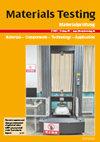X-ray diffraction and photoelectron spectroscopy analyses of MXene electrode material used in energy storage applications – a review
IF 2.4
4区 材料科学
Q2 MATERIALS SCIENCE, CHARACTERIZATION & TESTING
引用次数: 0
Abstract
X-rays have many uses in screening and materials characterization applications. X-ray diffraction (XRD) and X-ray photoelectron spectroscopy (XPS) analysis are among them. From the XRD data, a crystal structure can be determined by analysis of the XRD pattern, intensity, and positions of the peaks. Information about the crystallographic space group, lattice parameters, preferred orientation, and crystallite size can be derived. XPS examines the surface chemical state of a sample. This review will focus exclusively on MXene compounds and their analysis using XRD and XPS. MXene are layered compounds with a strong potential for application in energy storage. Since MXenes are two-dimensional (2D) transition metal carbides and nitride, the material exhibit signals indicating the presence of specific transition elements, 1s carbon, and 1s oxygen. Additionally, there is a possibility of detecting an element from group 13 or 14 of the periodic table, such as aluminum, nitrogen, or fluorine. A comprehensive study based on XRD and XPS analytical techniques of 2-dimensional electrode materials may provide advancement in the field of energy storage. MXene especially deserve attention due to their remarkable structural and electrochemical characteristics, such as conductivity, topological, and surface area, which attracted numerous researchers worldwide.储能应用中 MXene 电极材料的 X 射线衍射和光电子能谱分析综述
X 射线在筛选和材料表征应用中用途广泛。其中包括 X 射线衍射 (XRD) 和 X 射线光电子能谱 (XPS) 分析。根据 XRD 数据,可通过分析 XRD 图形、强度和峰值位置确定晶体结构。还可以得出晶体空间群、晶格参数、优先取向和晶粒大小等信息。XPS 可检测样品的表面化学状态。本综述将专门讨论 MXene 化合物及其利用 XRD 和 XPS 进行的分析。MXene 是一种层状化合物,在能量存储方面具有很大的应用潜力。由于 MXene 是二维(2D)过渡金属碳化物和氮化物,这种材料会显示出表明存在特定过渡元素、1s 碳和 1s 氧的信号。此外,还有可能检测到元素周期表第 13 或 14 族元素,如铝、氮或氟。基于 XRD 和 XPS 分析技术对二维电极材料进行全面研究,可能会推动储能领域的发展。MXene 因其显著的结构和电化学特性,如导电性、拓扑性和比表面积,尤其值得关注,吸引了全球众多研究人员的目光。
本文章由计算机程序翻译,如有差异,请以英文原文为准。
求助全文
约1分钟内获得全文
求助全文
来源期刊

Materials Testing
工程技术-材料科学:表征与测试
CiteScore
4.20
自引率
36.00%
发文量
165
审稿时长
4-8 weeks
期刊介绍:
Materials Testing is a SCI-listed English language journal dealing with all aspects of material and component testing with a special focus on transfer between laboratory research into industrial application. The journal provides first-hand information on non-destructive, destructive, optical, physical and chemical test procedures. It contains exclusive articles which are peer-reviewed applying respectively high international quality criterions.
 求助内容:
求助内容: 应助结果提醒方式:
应助结果提醒方式:


